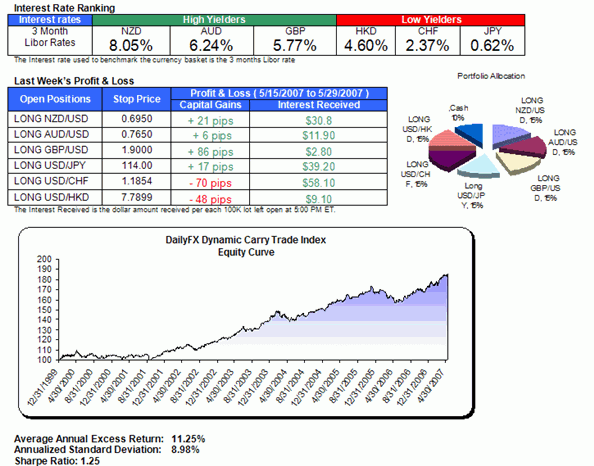Antonio Sousa writes that gains in NZD, AUD and GBP positions are being offset by losses in CHF and HKD.
In the last five trading days, the performance of our carry trade basket has been mixed. Gains in the NZD, AUD and GBP long positions were offset by losses in the Swiss franc and Hong Kong dollar. Still, we accumulated nearly $150 on interest payments and ended up having one more positive week.
A large amount of our profits were done in the sterling with 86 pips gain from 05/22 to 05/29. On the other hand, the biggest loss was taken in the Swiss franc, with a 70 pips plunge.
No changes were done in the basket since last week
What Are We Currently Long?
NZDUSD
AUD/USD
GBP/USD
USD/CHF
USD/HKD
USD/JPY 
Additional Information
In an ever changing world, making profitable carry trades* (definition below) are not as easy as they use to be. Therefore we have created a dynamic carry basket that changes when the monetary policy outlook for a central bank changes or if there is significant event risk ahead.
What is Carry Trade
All that is needed to understand the carry trade concept is a basic knowledge of foreign exchange and interest rates differentials. Money shifts from around the world in seek of the highest yield and the benefit of trading currencies is that you are dealing with countries that have interest rates, which are charged or received every single day. If you are positioned on the side of positive carry, you have the right to earn that interest, which can be quite lucrative over time.
Protective Stop-Loss
Substantial gains made from interest rate differentials provide undeniable evidence that the carry trade strategy has been very successful over the past few years. Still, this strategy involves significant risks and an adequate protective stop is required. We are using a protective stop-loss equivalent to five times the average true range.
Position Sizing
Our position size varies according to each currency volatility. Generally, the more volatile the currency is, the fewer lots we trade. For example, let's assume you have $10,000 and you are trading 10K lots, you decide to limit your risk per trade to 3% or $300 and the 90 days average true range for the EURUSD is 100 pips. In this case, if you go long EUR/USD you could buy 3 lots, since ($10000 * 3%) divided by (0.0100*10K) = 3 lots. In case the final result is not an integer you should always rounded it down to limit your exposure.
Antonio Sousa is a Currency Analyst for FXCM.